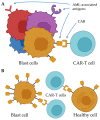The Problem of Molecular Target Choice for CAR-T Cells in Acute Myeloid Leukemia Therapy
- PMID: 40564892
- PMCID: PMC12192633
- DOI: 10.3390/ijms26125428
The Problem of Molecular Target Choice for CAR-T Cells in Acute Myeloid Leukemia Therapy
Abstract
Recently, the chimeric antigen receptor (CAR)-T approach represented a breakthrough in the treatment of B-cell malignancies, encouraging the application of the approach for other hematological diseases, such as acute myeloid leukemia (AML). Heterogeneity and antigen variation in the pathological cell population hinder the choice of molecular targets in the case of AML. In this review, the critical aspects were described that are usually considered when selecting molecular targets for the new CAR genetic constructs. The role of AML-associated antigens in AML progression was covered. In conclusion, we proposed an approach that may allow the elimination of pathological cells in AML more effectively.
Keywords: CAR T; acute myeloid leukemia; target choice.
Conflict of interest statement
The authors declare no conflicts of interest.
Figures


Similar articles
-
Evolving strategies to overcome barriers in CAR-T cell therapy for acute myeloid leukemia.Expert Rev Hematol. 2024 Nov;17(11):797-818. doi: 10.1080/17474086.2024.2420614. Epub 2024 Oct 30. Expert Rev Hematol. 2024. PMID: 39439295 Review.
-
Current developments in T-cell receptor therapy for acute myeloid leukemia.Blood Adv. 2025 Jun 24;9(12):3069-3089. doi: 10.1182/bloodadvances.2024014105. Blood Adv. 2025. PMID: 39813621 Free PMC article. Review.
-
CAR-T cell therapy for cancer: current challenges and future directions.Signal Transduct Target Ther. 2025 Jul 4;10(1):210. doi: 10.1038/s41392-025-02269-w. Signal Transduct Target Ther. 2025. PMID: 40610404 Free PMC article. Review.
-
The tandem CD33-CLL1 CAR-T as an approach to treat acute myeloid leukemia.Blood Transfus. 2025 Jul-Aug;23(4):338-347. doi: 10.2450/BloodTransfus.786. Epub 2024 Aug 6. Blood Transfus. 2025. PMID: 39133622 Free PMC article.
-
CD70 CAR T cells secreting an anti-CD33/anti-CD3 dual-targeting antibody overcome antigen heterogeneity in AML.Blood. 2025 Feb 13;145(7):720-731. doi: 10.1182/blood.2023023210. Blood. 2025. PMID: 39571145
References
-
- Ryan C. FDA Approves Obecabtagene Autoleucel for Adults with Relapsed or Refractory B-Cell Precursor Acute Lymphoblastic Leukemia. FDA; Silver Spring, MD, USA: 2024.
Publication types
MeSH terms
Substances
Grants and funding
LinkOut - more resources
Full Text Sources
Medical

